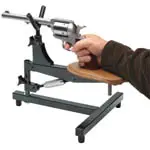|
Shooter's Ridge Steady Point Handgun Rest By Chuck Hawks  Outers originally offered this handy pistol rest several years ago; it has since been marketed by Shooter's Ridge (both companies are owned by ATK). I purchased mine (the original Outers Pistol Perch version) shortly after its introduction, as an aid for bench testing handguns. The Pistol Perch/Steady Point rest is fabricated from mild steel. The "T" shaped lower frame of the Pistol Perch is provided with three short legs (one leg in front and two in back). The feet have anti-skid rubber tips. There is a vertical steel post at the front of the frame (the long axis of the "T") that supports the actual rest part of the device. This consists of a "V" shaped rest for the pistol's barrel in front, and cantilevered to the rear of the support post is a flat, egg-shaped plate that supports the butt of the pistol and the shooter's hands. The front "V"--made of steel bar stock--is plastic coated to preserve the finish of the pistol's barrel. The steel butt rest plate of my Pistol Perch is covered with what appears to be a synthetic fleece. It reminds me of the fleece used for slip-on automobile seat covers. I believe that the Shooters Ridge Steady Rest version uses some sort of vinyl covered pad. In any case, the padding helps to control the pistol's tendency to jump away from hard surfaces on recoil. The front "V" barrel support is adjustable for height, as is the butt support plate, so that the pistol can be supported in a level position. The carriage that supports the butt plate can be adjusted to angle up or down so that the supported pistol can be aimed downrange at the correct elevation to hit the target. The whole assembly can also be rotated laterally around its front post, again to assist in aiming the supported pistol at the target. It is a clever system that allows the user to point the pistol pretty much where needed. The Pistol Perch/Steady Point rest generally provides a steadier support than simply shooting over a sandbag or most other temporary supports. There is some flex in the system; due primarily to the way the butt support plate is cantilevered rearward from the front post. So when the shooter rests the pistol and his or her hands on the butt support plate, he must be careful to use the same amount of force for each shot. Also, the pistol must be positioned with the barrel touching the front "V" in the same spot for each shot. I find that the closer to the frame the barrel touches the "V," the better. I often pad the "V" with several layers of cloth (an old facecloth, folded, works well) to minimize barrel jump. An exception is the way I rest traditional single action revolvers. The ejector housing running along the lower right side of the barrel makes these guns jump laterally as well as vertically when they are fired. I have found that the best way to avoid this is to rest the forward part of the frame, in front of the trigger guard, in the Steady Point's "V" rather than the barrel. As always when shooting from a bench rest, consistency is the key to tight groups. When sighting-in a pistol that will be used primarily unsupported thereafter, be sure to use the same grip on the gun when shooting from the Steady Point rest that you will use in the field. As experienced handgun shooters know, any change in grip will cause a change in the point of bullet impact. All in all, I regard the Steady Point rest as a worthwhile accessory for bench resting handguns. It is not perfect. There is too much flex in the system and I think that there should be more padding on the barrel support. But, once you get the hang of using it, the Steady Point is better than the other pistol rests I have tried. |